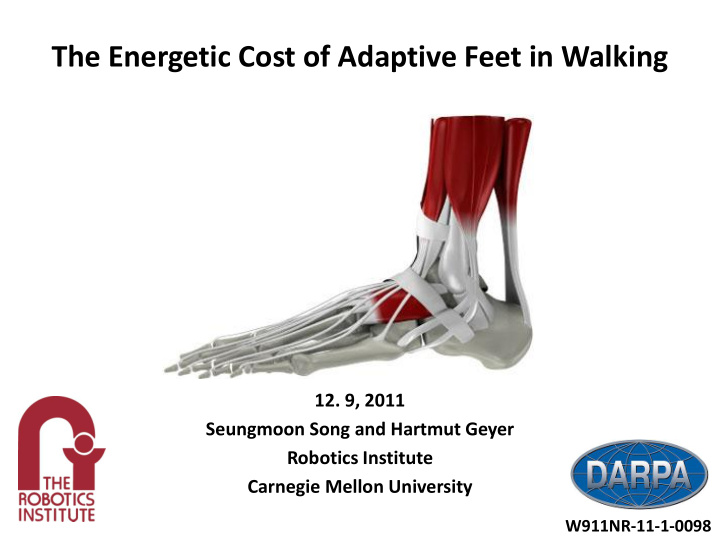



The Energetic Cost of Adaptive Feet in Walking 12. 9, 2011 Seungmoon Song and Hartmut Geyer Robotics Institute Carnegie Mellon University W911NR-11-1-0098
Related Studies Variable height (Kang et al., 2010) Variable stiffness (Hashimoto et al., 2010) Toe (Zhang et al., 2010, Zhu et al., 2011) Stiffness change (Briggs et al., 2001) Ball cushion (Bojsen-Moller et al., 1976) Windlass mechanism (Hicks, 1954) 1/10
How Much Do We Pay for Adaptive Feet? Baseline foot Absorbs impacts Provides secure grip Requires additional muscles Provides less power transfer Human foot 2/10
How Much Do We Pay for Adaptive Feet? Contents 1. Neuromuscular Model Baseline foot 2. Results 3. Future Direction Human foot
The Windlass Mechanism 1 ~ 2cm (Hicks, 1954 II, Bolgla et al., 2004) 3/10
How Much Do We Pay for Adaptive Feet? 1. Neuromuscular Model Baseline foot 2. Results 3. Future Direction Human foot TFL, TEX (Yamaguchi et al., 1990), PF (Gunther et al., 2002), MTJ (Hashimoto et. al, 2010)
Neuromuscular Model Control algorithm for robotic platforms Research platform for understanding human Model Human (Geyer et al., 2010) 4/10
Neuromuscular Model: Optimization (CMA-ES) Target speed Pain Energy cost Energy rate (Umberger, 2003), CMA-ES (Hansen, 2006) 5/10
How Much Do We Pay for Adaptive Feet? 1. Neuromuscular Model Baseline foot 2. Results 3. Future Direction Human foot
Neuromuscular Model: Simulation Baseline, 0.8ms -1 Human, 1.8ms -1 Human walking speed (Murray et al., 1984) 6/10
Result I: Human Feet Incur About 20% More Energetic Cost up to 1.2ms -1 7/10
Result II: Passive Feet Reduces the Energetic Cost by 15% or More 8/10
How Much Do We Pay for Adaptive Feet? 1. Neuromuscular Model Baseline foot 2. Results 3. Future Direction Human foot
Current and Future Directions Simulation studies to interpret the result Development of a robotic foot 9/10
Conclusion 1. Human Feet Incur About 20% More Energetic Cost up to 1.2ms -1 2. Passive Feet Reduces the Energetic Cost by 15% or more 10/10
Recommend
More recommend